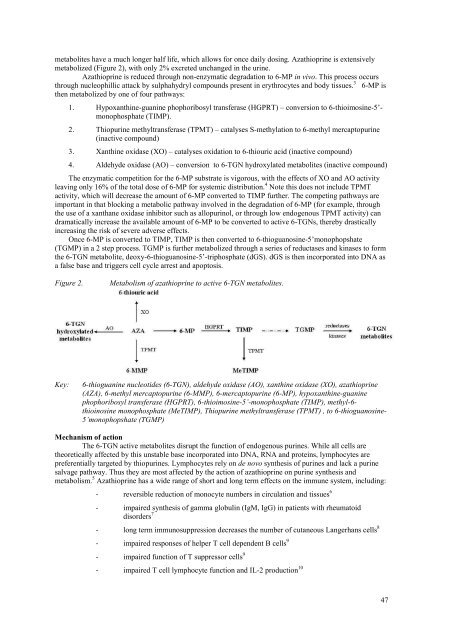Azathioprine and chlorambucil: mechanism of action and use in ...
Azathioprine and chlorambucil: mechanism of action and use in ...
Azathioprine and chlorambucil: mechanism of action and use in ...
You also want an ePaper? Increase the reach of your titles
YUMPU automatically turns print PDFs into web optimized ePapers that Google loves.
metabolites have a much longer half life, which allows for once daily dos<strong>in</strong>g. <strong>Azathiopr<strong>in</strong>e</strong> is extensively<br />
metabolized (Figure 2), with only 2% excreted unchanged <strong>in</strong> the ur<strong>in</strong>e.<br />
<strong>Azathiopr<strong>in</strong>e</strong> is reduced through non-enzymatic degradation to 6-MP <strong>in</strong> vivo. This process occurs<br />
through nucleophillic attack by sulphahydryl compounds present <strong>in</strong> erythrocytes <strong>and</strong> body tissues. 3 6-MP is<br />
then metabolized by one <strong>of</strong> four pathways:<br />
1. Hypoxanth<strong>in</strong>e-guan<strong>in</strong>e phophoribosyl transferase (HGPRT) – conversion to 6-thioimos<strong>in</strong>e-5’monophosphate<br />
(TIMP).<br />
2. Thiopur<strong>in</strong>e methyltransferase (TPMT) – catalyses S-methylation to 6-methyl mercaptopur<strong>in</strong>e<br />
(<strong>in</strong>active compound)<br />
3. Xanth<strong>in</strong>e oxidase (XO) – catalyses oxidation to 6-thiouric acid (<strong>in</strong>active compound)<br />
4. Aldehyde oxidase (AO) – conversion to 6-TGN hydroxylated metabolites (<strong>in</strong>active compound)<br />
The enzymatic competition for the 6-MP substrate is vigorous, with the effects <strong>of</strong> XO <strong>and</strong> AO activity<br />
leav<strong>in</strong>g only 16% <strong>of</strong> the total dose <strong>of</strong> 6-MP for systemic distribution. 4 Note this does not <strong>in</strong>clude TPMT<br />
activity, which will decrease the amount <strong>of</strong> 6-MP converted to TIMP further. The compet<strong>in</strong>g pathways are<br />
important <strong>in</strong> that block<strong>in</strong>g a metabolic pathway <strong>in</strong>volved <strong>in</strong> the degradation <strong>of</strong> 6-MP (for example, through<br />
the <strong>use</strong> <strong>of</strong> a xanthane oxidase <strong>in</strong>hibitor such as allopur<strong>in</strong>ol, or through low endogenous TPMT activity) can<br />
dramatically <strong>in</strong>crease the available amount <strong>of</strong> 6-MP to be converted to active 6-TGNs, thereby drastically<br />
<strong>in</strong>creas<strong>in</strong>g the risk <strong>of</strong> severe adverse effects.<br />
Once 6-MP is converted to TIMP, TIMP is then converted to 6-thioguanos<strong>in</strong>e-5’monophopshate<br />
(TGMP) <strong>in</strong> a 2 step process. TGMP is further metabolized through a series <strong>of</strong> reductases <strong>and</strong> k<strong>in</strong>ases to form<br />
the 6-TGN metabolite, deoxy-6-thioguanos<strong>in</strong>e-5’-triphosphate (dGS). dGS is then <strong>in</strong>corporated <strong>in</strong>to DNA as<br />
a false base <strong>and</strong> triggers cell cycle arrest <strong>and</strong> apoptosis.<br />
Figure 2. Metabolism <strong>of</strong> azathiopr<strong>in</strong>e to active 6-TGN metabolites.<br />
Key: 6-thioguan<strong>in</strong>e nucleotides (6-TGN), aldehyde oxidase (AO), xanth<strong>in</strong>e oxidase (XO), azathiopr<strong>in</strong>e<br />
(AZA), 6-methyl mercaptopur<strong>in</strong>e (6-MMP), 6-mercaptopur<strong>in</strong>e (6-MP), hypoxanth<strong>in</strong>e-guan<strong>in</strong>e<br />
phophoribosyl transferase (HGPRT), 6-thioimos<strong>in</strong>e-5’-monophosphate (TIMP), methyl-6thio<strong>in</strong>os<strong>in</strong>e<br />
monophosphate (MeTIMP), Thiopur<strong>in</strong>e methyltransferase (TPMT) , to 6-thioguanos<strong>in</strong>e-<br />
5’monophopshate (TGMP)<br />
Mechanism <strong>of</strong> <strong>action</strong><br />
The 6-TGN active metabolites disrupt the function <strong>of</strong> endogenous pur<strong>in</strong>es. While all cells are<br />
theoretically affected by this unstable base <strong>in</strong>corporated <strong>in</strong>to DNA, RNA <strong>and</strong> prote<strong>in</strong>s, lymphocytes are<br />
preferentially targeted by thiopur<strong>in</strong>es. Lymphocytes rely on de novo synthesis <strong>of</strong> pur<strong>in</strong>es <strong>and</strong> lack a pur<strong>in</strong>e<br />
salvage pathway. Thus they are most affected by the <strong>action</strong> <strong>of</strong> azathiopr<strong>in</strong>e on pur<strong>in</strong>e synthesis <strong>and</strong><br />
metabolism. 5 <strong>Azathiopr<strong>in</strong>e</strong> has a wide range <strong>of</strong> short <strong>and</strong> long term effects on the immune system, <strong>in</strong>clud<strong>in</strong>g:<br />
- reversible reduction <strong>of</strong> monocyte numbers <strong>in</strong> circulation <strong>and</strong> tissues 6<br />
- impaired synthesis <strong>of</strong> gamma globul<strong>in</strong> (IgM, IgG) <strong>in</strong> patients with rheumatoid<br />
disorders 7<br />
- long term immunosuppression decreases the number <strong>of</strong> cutaneous Langerhans cells 8<br />
- impaired responses <strong>of</strong> helper T cell dependent B cells 9<br />
- impaired function <strong>of</strong> T suppressor cells 9<br />
- impaired T cell lymphocyte function <strong>and</strong> IL-2 production 10<br />
47
















